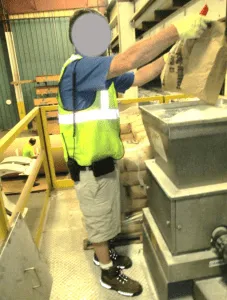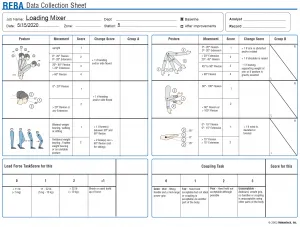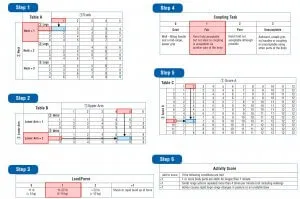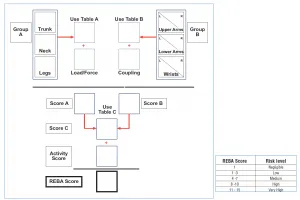How to Use the Rapid Entire Body Assessment
Posted on May 18, 2020 | in Ergonomics
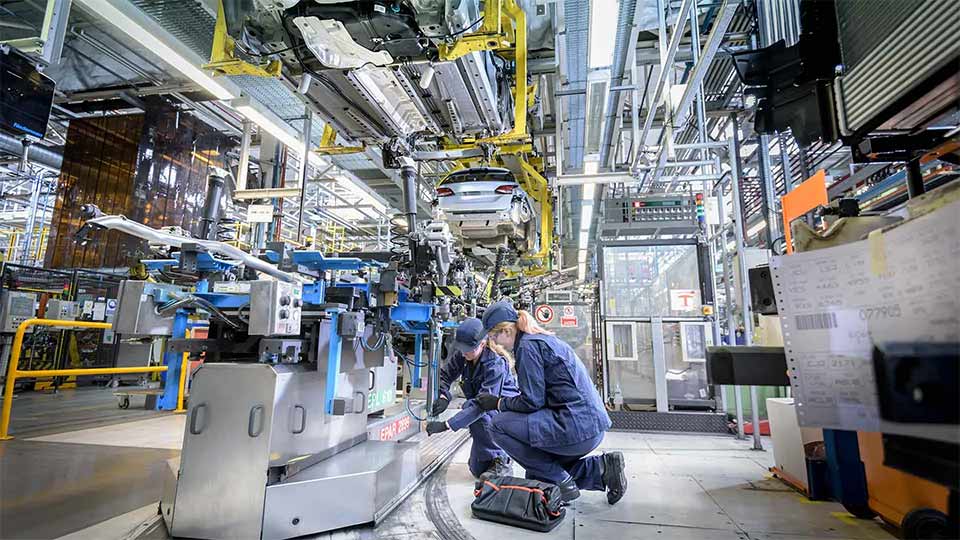
What is the REBA?
The Rapid Entire Body Assessment (REBA) is a tool used to evaluate the risk of musculoskeletal disorders (MSDs) associated with specific tasks within a job. It is a whole-body screening tool that follows a systematic procedure to assess biomechanical and postural loading on the body. The benefits of this tool are that it is simple, quick, and requires minimal equipment (pen and paper) making it easy to complete multiple assessments per task or per job. The REBA evaluates the whole body and it can be used to assess any task.
How to Complete the REBA
Step 1: Identify a job.
You can identify a job to assess by reviewing where past injuries have occurred, where operator complaints have been reported or where quality issues have been a concern.
Step 2: Define and understand the tasks within the job.
Interview the operator to gain an understanding of the main job tasks, the task demands, and what the operator perceives to be the most difficult component(s) of the job.
Step 3: Identify the tasks within the job you intuitively believe have the highest MSD risk.
From personal observation and the information gathered from the operator interview, select the “worst” parts of the task to assess. This should be based on the most awkward postures present, the highest force exerted, awkward postures held for an extended period of time, or awkward postures that are repeated multiple times.
Step 4: Capture the “worst” moment with a photo.
For example, take a photo of an operator lifting a 50-pound box from a pallet located on the floor, or a photo of an operator reaching across the width of a work table to retrieve a 25-pound bundle.
Step 5: Complete the REBA data collection form.
The REBA evaluates the whole body, including the upper arm, lower arm, wrist, neck, back and legs. From the photo, compare the position or postures of each body segment to those outlined on the REBA data collection form. The REBA provides a score for each body segment based on these postures. Note that the upper limbs must be analyzed separately (right versus left upper limb) if they are performing different actions.
Step 5: Determine the REBA score.
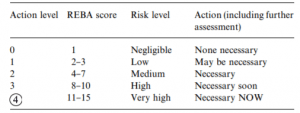 The REBA provides a single final score based on the posture evaluated, force requirements, type of movement, frequency of movement and coupling observed within the task. This single value, ranging from 1 to 15, represents the work-related MSD risk to the operator. It also provides a level of urgency for engineering changes to the workstation. A score greater or equal to 8 indicates that there is high MSD risk to the workers completing the task and that engineering controls are recommended.
The REBA provides a single final score based on the posture evaluated, force requirements, type of movement, frequency of movement and coupling observed within the task. This single value, ranging from 1 to 15, represents the work-related MSD risk to the operator. It also provides a level of urgency for engineering changes to the workstation. A score greater or equal to 8 indicates that there is high MSD risk to the workers completing the task and that engineering controls are recommended.
Step 6: Continue the job improvement process.
If you have a low- to very high-risk REBA score, you may need to generate solutions to lower MSD risk to the worker. To effectively do this, start by identifying where the main issues are; analyze the REBA data collection form to see which areas contributed the most points to the overall REBA score. For each high-risk factor identified, complete a “5-Why” analysis to find the true root cause of the problem (i.e., ask yourself why you got this score). Next, focus on fixing the problem; brainstorm improvements and implement them when it is financially feasible (tip: the solution should be the natural inverse of the true root cause).
After the improvement(s) have been implemented, check your work. Complete another REBA data collection form; if your improvements were effective you should see a lower REBA score. This step is very important – it allows the evaluator to check in with the operators (do they like the change or are they adapting to the change) and it ensures that the improvement did not introduce new MSD risk factors.
Lastly, you want to make sure you are sustaining the improvement. If needed, train the operators, update the Standard Operating Procedure and gather employee feedback. Also, look for opportunities to expand the benefits from this improvement to other workstations.
An Example of the REBA
Limitations of the REBA
Overall, the REBA is a very quick and easy tool you can use to evaluate any task. However, there are limitations to consider when selecting the correct tool for an ergonomics assessment.
First, the REBA can only assess one posture, at a single point in time; therefore, the results do not include other high-risk parts of the task. To address this, you can complete multiple REBAs per task or you can consider a task-based assessment tool to capture the interaction of different MSD risk factors within a task.
Second, the evaluator must decide what the “worst” part of the task is. This may vary among operators, and it also may vary between evaluators. For example, is the “worst” part of the task the posture that results in the most operator discomfort, the most frequently repeated posture or the highest force exerted by the operator. Overall, the subjectivity of selecting the “worst” posture to evaluate can result in scoring differences. To address this, consider a task-based assessment tool to capture all steps within the task and to evaluate the interaction of the MSD risk factors present.
Lastly, like most survey-style tools, it requires some subjectivity to select the right threshold. To address this, consider motion capture technology to reduce human error and subjectivity. For more information about selecting the correct ergonomics assessment tool, please read our e-book on this topic.
Citations
